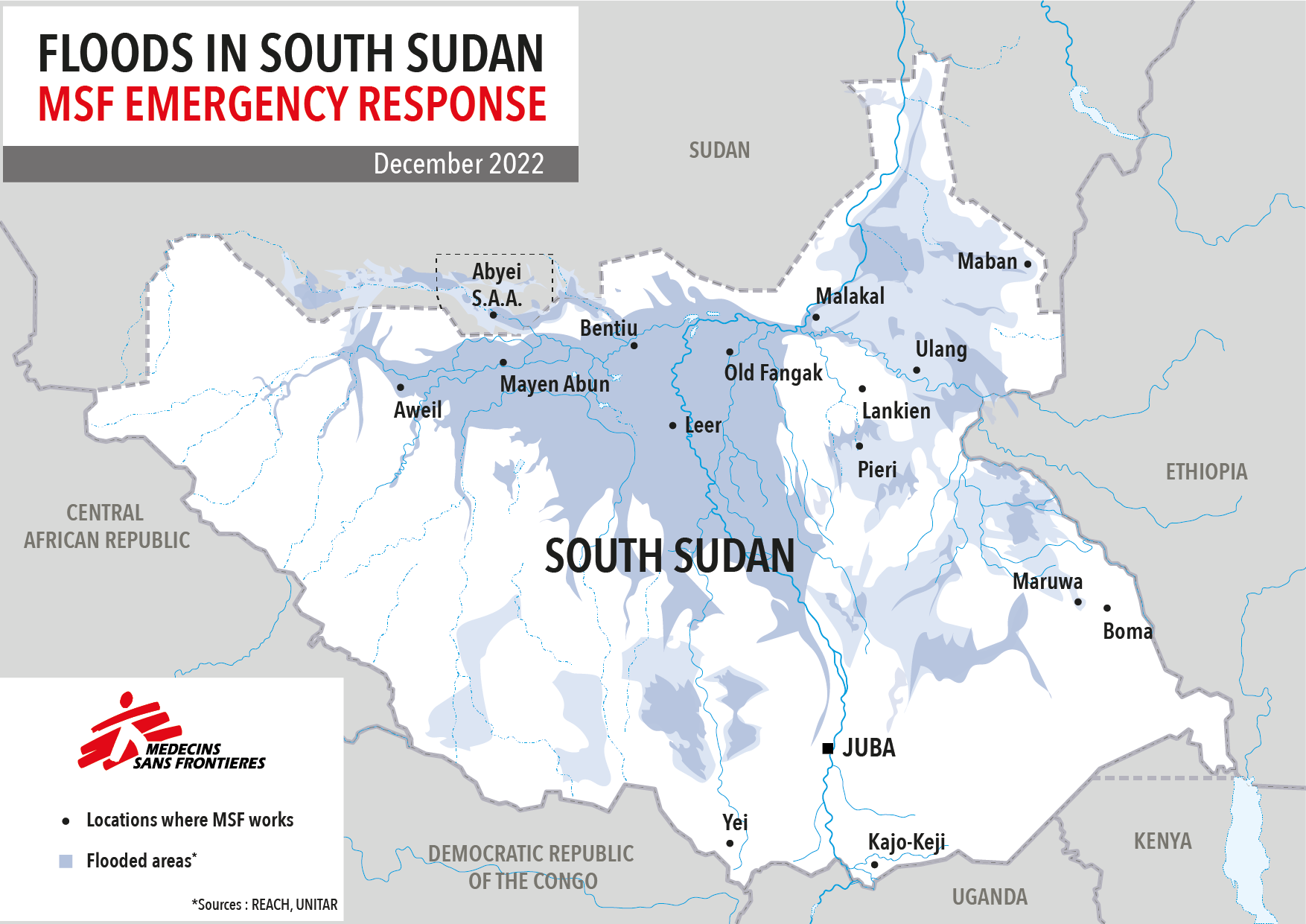A small makeshift raft made from plastic sheeting and filled with dry grass is drifting along the Nile river. Upon it, sits a family of eight people – the youngest just a baby.
On this small raft is everything they own: some clothes, and a few pots to cook with, which are mostly filled with waterlilies they pluck from the water. Behind them, their village is almost fully submerged by floodwaters.
The family had to leave quickly before the water got too high to wade through. They travelled by makeshift rafts or canoes dugout from tree trunks to get to safer land.
As many countries in Eastern Africa suffer the worst drought in four decades, South Sudan sits uneasily on the opposite end of the spectrum – saturated by years of intense flooding that has affected more than one million people in the country.
To make matters worse, the response to the devastation of the flooding has fallen far short of satisfactory. Humanitarian organisations, UN agencies and governments must step up to address the scale of the crisis and the overwhelming need for food, shelter, medical care and other basic essentials for people impacted by the floods.

Flooding in South Sudan
Four consecutive years of flooding have left about two-thirds of the country under water, with Jonglei, Northern Bahr El Ghazal, Upper Nile, Unity, Warrap, Western Equatoria, and Lakes States in South Sudan and Abyei Special Administrative Area, all experiencing severe floods in the past few months.
Seasonal flooding of the Nile river and tributaries is typical, however, the flooding in the past few years has been unprecedented. Residents say that the rainy season has been starting earlier and lasting longer. Even the intensity of the rain has been significantly higher than in the past.
The water levels have been so high and the soil so waterlogged that the waters have not fully receded in the intervening dry seasons. Consequently, there has been rapid inundation during the rains, compounding the crisis each consecutive year since 2019.

Communities prepare themselves for the rainy season by building dykes – walls made from soil to hold back the water from their villages. But this year, contingency preparations were not sufficient to hold back the deluge of water. In Ulang County, for instance, entire villages were submerged in October when dykes broke due to heavy rains. Health facilities, schools and many houses were all flooded.
“The floods displaced everyone. It flooded all the villages and the livestock drowned as well. Our house collapsed in the flood. It was a huge disaster for us,” says Nyanyieth Bang, displaced by floods in Doma in Ulang.
From one day to another, villages became separated from each other, with many communities finding themselves marooned on “islands” and cut off from services, which are now only accessible by boat or canoe. Médecins Sans Frontières (MSF) teams are running outreach services and mobile clinics to ensure healthcare is available for the most vulnerable people in remote areas. However, reaching some communities remains a huge challenge.

“Flooding impacts our capacity to deliver aid and reach communities in need,” says Aline Serin, MSF head of mission in South Sudan. “Many roads across the country are rendered impassable by the flooding. In a number of locations where we operate, our planes have been unable to land due to flooding of the airstrips,” she says.
“This lack of access inhibits our ability to bring in medical supplies and other essential items, which puts lives at risk. It also impacts our ability to transfer patients who require emergency treatment.”
Large swathes of stagnant floodwater have also become the perfect breeding ground for mosquitoes, leading to an explosion of malaria cases. Between July to September this year, MSF treated 81,104 patients with malaria.
The floods have displaced hundreds of thousands of people, killed millions of animals and destroyed thousands of acres of crops, compounding an escalating food security crisis in the country. The UN World Food Programme estimates that more than 75 per cent of people in South Sudan are in need of food assistance.
Our teams are witnessing a worrying increase in rates of moderate to severe acute malnutrition. Between January to September this year, more than 4,200 children were treated for malnutrition across our medical facilities in South Sudan.
With nowhere else to go, tens of thousands of people have resorted to living in displacement camps. The lack of shelter, safe drinking water and sanitation facilities in the camps are resulting in outbreaks of infectious and water-borne diseases and other health risks. The result has been a humanitarian disaster for people who already endure far too many of them.

Although the country is now entering the dry season, there appears to be no reprieve on the horizon. The devastating impact of the loss of crops and livestock are expected to result in rising rates of malnutrition. With the majority of people in South Sudan being pastoralists, there is also an increased risk of cattle raids to regain animals lost during the floods, leading to flare ups of inter-communal violence.
Despite the urgent and increasing humanitarian needs in South Sudan, international aid cuts are resulting in diminishing responses to people who have very few resources after experiencing consecutive crises. The humanitarian response needs to be scaled up urgently to ensure people who remain in extremely precarious conditions have access to basic essentials, including food, healthcare and shelter.



